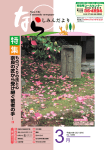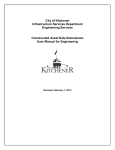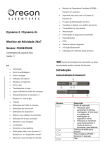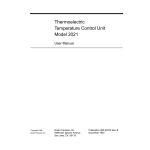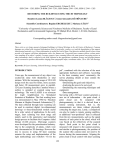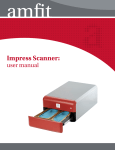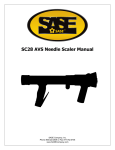Download Section 3 - State Historical Society of Iowa
Transcript
SECTION 3: ARCHAEOLOGICAL RESOURCES Table of Contents: Section 3 Flow chart for activities involving earthmoving Introduction Projects not normally requiring SHPO review Quick-look chart for determining if SHPO consultation is necessary using the qualifying criteria Quick-look chart for determining whether SHPO review is required 3.2 3.3 3.3 3.5 3.7 Appendices A The Archaeological Site File Search B Preparing a Submittal for Review C Example Submittal for SHPO Review SHPO Consultation User’s Manual 04.2005 Page 3.1 FLOW CHART FOR ACTIVITIES INVOLVING EARTHMOVING Are there any standing structures or nonarchaeological resources within the project APE? Consult Section 2 for Projects Involving Architectural/historical Resources Yes No Does the action meet the Qualifying Criterion #1 or #2 for categorical exemption from SHPO review? No No Is the action an exempt activity according to the PMOU? Yes Yes Does the action meet Qualifying Criterion #3 for categorical exemption from SHPO Review? Yes No CONSULTATION WITH SHPO IS REQUIRED! Verify whether consultation regarding architectural/historical resources is required (see Section 2) and submit all appropriate documentation to consulting parties for 30-day review, in accordance with the submittal checklist. Prepare and file an Exempt from SHPO Review, Project Determination Form (Form 1.B). NO FURTHER CONSULTATION WITH SHPO IS REQUIRED! Did you receive a 30-day notice of receipt via email from SHPO within one week of project submittal? No Your submittal was incomplete and will be returned to you for additional information. Carefully review your submittal checklist and resubmit information to SHPO for 30-day review. Yes SHPO will review submittal and provide comments via email by the date indicated in the 30-day email notice. SECTION 3: ARCHAEOLOGICAL RESOURCES INTRODUCTION The guidance in this section is applicable to projects involving earthmoving that could disturb archaeological deposits, features, ruins, and/or cultural landscapes. Section 3 will discuss the criteria for categorical exemption of certain earthmoving activities not normally requiring SHPO review and how to apply them. It will cover a list of activities that have been categorically exempted from SHPO review, the appropriate procedures for coordinating consultation with the SHPO on non-exempt activities, and the documentation standards that have been established for SHPO consultation. PROJECTS NOT NORMALLY REQUIRING SHPO REVIEW Some earthmoving projects have greater potential to adversely affect significant archaeological properties than do others. For instance, the construction of a new fiveacre sewage treatment plant on a ‘raw land’ alluvial terrace has much greater potential to encounter a significant prehistoric site than would a similar project located in an upland area that had been profoundly disturbed by a previous highway project. Qualifying Criteria: The following is a list of qualifying criteria. These are the first questions you should ask to determine whether SHPO consultation is required. If either Criteria 1 or 2 and Criterion 3 are met document the determination in the file using the Exempt Project Determination Form and you are done. No SHPO consultation regarding archaeological resources is required. However, it may still be necessary to complete consultation with SHPO regarding Architectural/Historical resources that may be involved (please see Section 2). 1. The Area of Potential Effect (APE) has been intensively surveyed after 1989 and determined by the federal agency not to contain historic properties, and this finding was accepted by the SHPO. (Please note that an activity can be excluded from SHPO review under Criterion 1 only if Criterion 3 also applies). It is assumed that archaeological surveys performed after 1989 employed techniques that are consistent with current standards. Most of the archaeological survey coverage for the State of Iowa has been digitized and placed on the I-Sites geographical information system database (GIS) maintained by the University of Iowa Office of the State Archaeologist (OSA) in Iowa City. Because of the sensitivity of the information, I-Sites offer two levels of on-line accessibility. The public access site contains basic information that identifies the number of reported archaeological sites by township section. Site and survey locations are not provided. The professional access site is available only to professionals who are registered with the OSA. This side of I-Sites not only identifies site and survey locations, but also provides links to other archaeological databases. SHPO Consultation User’s Manual 04.2005 Page 3.3 Information regarding past survey work may also be obtained by those with a demonstrated need-to-know by consulting the records at SHPO and at the OSA. We ask that patrons contact us in advance to ensure that SHPO staff will be able to assist in accessing the requested files. 2. If the APE has been profoundly disturbed. (Please note that an activity can be excluded from SHPO review under Criterion 2 only if Criterion 3 also applies). One misconception frequently held by project proponents is that since a land parcel has been cultivated - sometimes for decades - it has been previously disturbed and therefore no significant archaeological deposits could possibly remain. While the land may have been subject to past agricultural disturbance, it may not have been profound. In other words, the potential for significant archaeological deposits remains. ‘Profound disturbance’ occurs when a past activity or activities have physically altered the three-dimensional Area of Potential Effects (APE) in its entirety to the point where there is no potential for an archaeologically significant property to remain. One must remember that the project APE is three-dimensional, and while there may be no apparent signs of a site located at the surface, intact deposits and features may be present well-below the modern land surface and still within the APE. In Iowa, prehistoric archaeological sites have been discovered at depths from 20 to 25 feet below surface - and deeper. In order to cite exclusion from SHPO review under Criterion 2, profound disturbance of the entire APE must be demonstrated through archival sources. 3. The project will NOT involve buildings, districts, objects, structures, sites, or landscapes in the APE that are more than 50 years old. (Please note that an activity cannot be categorically excluded under Criterion 3 alone, but must also meet the conditions of either Criteria 1 or 2). An OSA archaeological site file search is strongly recommended as a first step for all projects that involve earthmoving (see Appendix 3.A, and Appendix 3.B, Figures 11 and 12). If, in the absence of other types of properties that are 50 years in age or older, an OSA search reveals the presence of an unevaluated archaeological site in or immediately adjacent to the project APE, then exemptions under criteria 1 and 2 do not apply. If, on the other hand, an archaeological site (in the absence of other types of unevaluated properties that are 50 years in age or older) was identified and SHPO Consultation User’s Manual 04.2005 Page 3.4 evaluated as Not National Register Eligible by a survey conducted after 1989 that completely covered the current APE and SHPO concurred with the findings of the survey and the National Register evaluation; or, the site, and the whole of the current APE, were profoundly disturbed by a previous earthmoving event, then Criterion 1 and 2 would apply. Please remember that the OSA site file search only reports the existence of reported archaeological sites. So, a negative search does not necessarily mean that there are none present and that the project is automatically exempted from SHPO review. There are many archaeological sites in the state that have never been reported and do not appear in the State’s inventory, but are known to local collectors and historians. Additionally, the absence of archaeological sites in the State’s inventory for any given parcel of land may merely indicate that the area in question has never been systematically surveyed for archaeological resources. It must be remembered that the project proponents are not only responsible for identifying known sites, but any sites that might be present within the APE that are presently unknown. Information on the eligibility of an archaeological site can be obtained by contacting the SHPO Inventory Coordinator (see Appendix 1.B). Please note that the site National Register eligibility recommendations on the completed Iowa Archaeological Site forms does not reflect whether the SHPO concurred with those recommendations. The National Register archaeological site status database maintained by the SHPO is the only source that contains the records of SHPO findings. Finally, one must remain vigilant of the undertaking’s potential to cause indirect effects to other types of properties such as buildings and districts. For instance, a project that proposes the construction of apartments on an infill lot in a large city may be exempt from SHPO’s archaeological review but it may still require review from its Architectural Historian particularly if the activity will take place within the boundaries of an historic district or adjacent to an individually eligible or listed property. If you have difficulty in applying the criteria or have any questions concerning them, contact either the review staff at SHPO or the Environmental Review Officers at IDED or DNR for assistance. Use the quick-glance chart below to determine if SHPO consultation is necessary using the qualifying criteria. Does Does the activity qualify criteria 3 Is further consultation with for exemption under apply? SHPO required? Criteria 1 or 2? No Yes Yes No No Yes Yes Yes *No * Assumes the absence of other types of historic properties. SHPO Consultation User’s Manual 04.2005 Page 3.5 Exempt Activities: If the undertaking does not meet the qualifying criteria above, but is included in the exempt activity list below, the project will have little potential to affect a property, even if historic properties are present. If any of the following are met, document the determination in the file using the Exempt Project Determination Form and you are done. No SHPO consultation regarding archaeological resources is required. However, it may still be necessary to complete consultation with SHPO regarding Architectural/Historical resources that may be involved (please see Section 2). The following activities are considered exempt from further review by the SHPO archaeologist because they have limited potential to affect historic properties: 1. 2. 3. 4. 5. 6. 7. 8. 9. 10. 11. 12. 13. 14. 15. 16. 17. 18. Photoscopic pictures and video of water and/or sewer pipe. Re-lining of water and/or sewer pipe. Point repairs of water and/or sewer pipe. Hydrant replacements Manhole cover replacements. New/replacement service lines and related appurtenances involving boring or slit trenches up to 6” (inches) in width. Equipment replacement, purchase, removal, and/or installation. Disturbance confined to the current footprint of the compound such as buildings, water treatment plants, and/or sewer treatment plants. Directional boring of utility lines without sending or receiving pits. Connecting pits relating to directional boring for utility lines no bigger than 10 feet by 10 feet. Parallel water and/or sewer mains installed within 5 feet of the original (existing) routes and if no known National Register of Historic Placeslisted or eligible sites or historic districts are within the Area of Potential Effects. Wells in existing well fields. Geotechnical borings and environmental monitoring wells if no recorded sites are in the vicinity. Replacement of concrete or asphalt sidewalks. Replacement (demolition) of water towers less than 50 years old on the same building parcel less than 1 acre in size when the new tower is not over a 10% increase in capacity or 20 feet in height as compared to the existing water tower. Utility upgrades without land disturbance. Parking lot rehabilitation or construction of less than one acre in size, located on row-cropped agricultural land provided that any ground disturbance activities will be confined to the plowzone, which generally extends 10 to 12 inches below surface. Overhead power line and telecommunication cable replacement. SHPO Consultation User’s Manual 04.2005 Page 3.6 19. 20. 21. Resurfacing and/or rehabilitation of existing concrete or asphalt roads, drives, or entries where the area is within both existing horizontal and vertical alignments. Conversion of an existing gravel road to concrete or asphalt where the area is within to existing horizontal and vertical alignment. Pavement widening and/or should construction and the addition of auxiliary lanes, such as turn lanes or climbing lanes where the area is within both existing horizontal and vertical alignment of an existing rightor-way. Exempt from SHPO Review, Project Determination Form: If the project is exempt from SHPO review, either because the subject property meets the Qualifying Criteria or the proposed project is on the Exempt Activities list, then you should document the exemption on an Exempt from SHPO Review Project Determination Form (Form 1.B). This form should be filed in your project file and submitted according to the Monitoring and Reporting section of the PMOU. Use the quick-glance chart below to determine whether SHPO review is required. Does the proposed action meet the “Qualifying Criteria”? Is the activity exempt? Is further consultation with SHPO required? Yes No No Not applicable Yes No No. File Exempt Project Determination Form. No. File Exempt Project Determination Form. Yes. Submit appropriate information to SHPO. SHPO Consultation User’s Manual 04.2005 Page 3.7 APPENDIX 3.A: THE ARCHAEOLOGICAL SITE FILE SEARCH The OSA is charged with the responsibility of maintaining the files on all reported archaeological sites located in the State of Iowa. The OSA also maintains I-Sites, which is the on-line version of the State Archaeological Site files. Because of the sensitivity of the information, I-Sites offer two levels of on-line accessibility. The public access site contains basic information that identifies the number of reported archaeological sites by township section. Site and survey locations are not provided. The professional access site is available only to professionals who are registered with the OSA. This side of I-Sites not only identifies site and survey locations, but also provides links to other archaeological databases. An archaeological site file search, performed by OSA staff, provides professional-level access to site specific information on a need-to-know basis, which goes beyond what is available through the public access version of I-Sites. This service is available to project proponents at a nominal fee. This information is also available by visiting the OSA Offices in Iowa City or the SHPO in Des Moines. An archaeological site file search is strongly recommended as a first step for all projects that involve earthmoving. An OSA site file search can be requested by contacting Ms. Colleen Eck at (319) 3840735, or by email at [email protected]. You will be asked to complete an OSA site file search request form, attach a project location map, and submit it to the Site File Coordinator for processing. The following is an example of a completed OSA site file search request form with the attached project location map. SHPO Consultation User’s Manual 04.2005 Page 3A.3 REQUEST FOR IOWA SITE FILE SEARCH Name: Farfel Mittelschmerz________________________________________________ Company/Agency: FUNCO Address: 423 Eisenaugen Ave, Suite 45, Zoar IA 55555 Phone Number:(319) 334-9087 FAX Number (business number only):(319) 334-9088 Email [email protected] Listed on the Iowa SHPO Archaeological Consultants List I am: Certified by the Society of Professional Archaeologists On Registry of Professional Archaeologists X Other qualifications (specify): Lead Federal Agency Official Purchase Order No. (if any): 4930554 Provide Information for this search by: Fax Mail X Email Agencies Sponsoring or Funding Project: HUD CDBG WS-0001 / EPA-DNR SRF-05-0001 Is this search for Section 106/NEPA Compliance? X Area of Search Yes No County: Cedar Township: T83N Range:R11W Section: 18 Quarter Section(s): SW Township: T83N Range:R11W Section: 19 Quarter Section(s) W ½ USGS Quadrangle Map(s) Name (Please attach with project outlined): Zoar (see attached) [search will be conducted for sites within one mile of project area] Maps may be downloaded and printed at http://cairo.gis.iastate.edu/new_site/ (please use 1:24000 quads) Repository for Project Documentation: City of Zoar FOR OSA USE ONLY (below line) ISF Search No. Date Received Search Conducted by: Date Completed: Material Sent: Method Sent: Office of the State Archaeologist Site Location Maps Other Phone (minutes) 700 Clinton St. Bldg. Site form copies (pgs) Letter Fax (pages) Mail (ounces) Iowa City, Iowa 52242-1030 SHPO Consultation User’s Manual 04.2005 Email 319/384-0732 FAX 319/384-0768 E-mail: [email protected] Page 3A.4 Zoar Consolidated Wastewater Treatment Project Project Area Zoar Quad ____________________________________________________________________ Upon completion of the search, the OSA will issue the results in the form of a dated letter and print out(s) of the relevant site/survey location maps and site file database entries. The site file search covers an area that extends one-mile in diameter around the project location. If sites fall within the project area of potential effects they are identified on the map. If sites fall outside of the APE but within the search perimeter their locations are withheld and the pertinent township section is shaded and the number of sites in that section indicated. The database printout lists information (site number, cultural affiliation, site type, site area) for all of the sites identified by the search. SHPO Consultation User’s Manual 04.2005 Page 3A.5 Please remember that the OSA site file search only reports the existence of reported archaeological sites. So, a negative search does not necessarily mean that there are none present and that the project is automatically exempted from SHPO review under Criterion 3 (above). Information on the eligibility of an archaeological site can be obtained by contacting the SHPO Inventory Coordinator (see Appendix 1.B). Please note that the site National Register eligibility recommendations on the completed Iowa Archaeological Site forms does not reflect whether the SHPO concurred with those recommendations. The National Register archaeological site status database maintained by the SHPO is the only source that contains the records of SHPO findings. There are many archaeological sites in the state that have never been reported and do not appear in the State’s inventory, but are known to local collectors and historians. Additionally, the absence of archaeological sites in the State’s inventory for any given parcel of land may merely indicate that the area in question has never been systematically surveyed for archaeological resources. Finally, the site information obtained through the OSA is considered confidential and is protected under federal (16 U.S.C. §470w-3) and state laws [IC§22.7(.21)]. It must be withheld from public access and redacted from all official publications such as public notices, environmental assessments (EA), environmental impact statements (EIS), findings of no significant impacts (FONSI), and records of determinations (ROD). Transfer of this information to parties other than the Responsible Entity, agency official or SHPO must first be approved by the State Archaeologist. SHPO Consultation User’s Manual 04.2005 Page 3A.6 APPENDIX 3.B: PREPARING A SUBMITTAL FOR REVIEW Standardization of project submittals is an essential component of fulfilling our goal to stream-line the SHPO review process. Providing SHPO staff with complete and relevant information in a timely manner ensures a comprehensive review, quick turnaround, and hopefully will eliminate - or at least minimize, the number of problems that can occur on a project down the road. The discussion below details all of the documents necessary when compiling a project submittal for SHPO’s archaeological review. 1. COVER LETTER (Figures 1A-C). All submittals should be made under a cover letter prepared by the Responsible Entity or an official for the lead federal agency. The letter should include clear and concise descriptions of the undertaking’s scope and of the project’s area of potential effects. If the undertaking is co-sponsored by more than one federal agency, this should also be noted. The other agencies should be identified and details of their actions provided. Remember, by agreeing to take the lead in section 106 compliance, the lead federal agency is legally bound to fulfill the compliance obligations of the other agencies. For instance if the HUD applicant takes the lead on a project in which the community is receiving a CDGG grant for the creation of a new sewage treatment plant, a DNR SRF loan for a new force main, and a 404 wetland permit from the Corps of Engineers, then the CDBG applicant is responsible for the entire combined APE, and not just that portion tied to the sewage treatment plant. 2. REQUEST FOR SHPO COMMENT ON PROJECT FORM (Figure 2). The central document in all HUD and EPA/SRF project submittals is the REQUEST FOR SHPO COMMENT ON PROJECT form (Figure 1). A copy of this form and instructions on its completion can be downloaded at: http://www.iowahistory.org/preservation/review_compliance/review_compliance.html The REQUEST form was originally designed specifically for HUD projects. However, other agencies, despite the HUD references, have adopted it for their own use. SHPO staff is now developing agency-specific versions of this form. Accompanying the REQUEST form are the various attachments that support the Responsible Entity’s stated determination of effect. These include, but are not limited to the following: project maps, project plans, aerial and site overview photographs, the results of historic properties investigations, and site inventory forms. The form calls for specific, basic documentation; however, the submitter may include other documents that he/she judges to be pertinent to SHPO’s review such as historic maps, Sanborn Fire Insurance maps, historic photographs and the like. When completing the REQUEST form, be sure to do the following: SHPO Consultation User’s Manual 04.2005 Page 3B.3 1) Indicate whether the submittal relates to a new project or one that is already on file with the SHPO. In the case of the latter, always be sure to include SHPO’s review and compliance number. 2) Complete all of the lines a-g in section I, and all of the appropriate check boxes in Section II. 3) Number of acres in the project APE. The acre is the standard unit of measurement for the horizontal dimension of the project APE. This information also allows SHPO to calculate the landmass subject to reconnaissance and intensive survey, and SHPO review at any point or interval in time. Many engineering and GIS programs can calculate area automatically and accurately. There are also metric conversion programs available on line. If these options are not available, the calculation of acreage is relatively simple to perform (total square footage ÷ 43, 560 = acres). In instances where the total project APE is less than 1-acre in size it is acceptable to defined it on the REQUEST form as <1acre. Failure to identify the APE acreage on the REQUEST for will result in SHPO’s return of the project submittal without further review. 4) Legal location: Section, Township, and Range. Identification of the project’s legal location is necessary so that the SHPO can enter and track the project location in the departmental database, hardcopy reference maps, and GIS data layers. This information can be obtained online at: www.ortho.gis.iastate.edu. In the past SHPO has received legal descriptions of land parcels in lieu of the section, township, and range. This only presents a problem if the section, township, and range are not included within the description. It also slows SHPO’s project login process when it is not identified on the REQUEST form leaving the 106 Coordinator to search through the rest of the submittal. Failure to identify the legal location on the REQUEST form will result in SHPO’s return of the project submittal without further review. 5) Check the box identifying the appropriate agency determination in Section III. DO NOT CHECK MORE THAN ONE DETERMINATION OF EFFECT. Submittals stating more than one determination will be returned to the sender. Remember, SHPO’s 30-day review and comment period begins when it has received a request to review an agency’s determination of effect. SHPO is under no time obligation if a determination has not been sent or if conflicting determinations are provided. 6) The form must be signed by the Responsible Entity or an official from the lead federal agency. Be sure to type or print the name and title below the signature line. 2. SUPPORTING DOCUMENTS FOR PROJECTS INVOLVING EARTHMOVING. A. Project location map (Figure 3). The Iowa SHPO and OSA use the 7.5 minute series of USGS Topographic quadrangle maps (Quads) as their base of reference. Most of Iowa’s archaeological site and survey information has been plotted on either hardcopy or electronic versions of these maps. The USGS quads also provide very useful information regarding local relief and landforms, SHPO Consultation User’s Manual 04.2005 Page 3B.4 drainage, and landuse that always contributes to SHPO review. Copies of these maps can be downloaded at: www.ortho.gis.iastate.edu. Quad maps included in a SHPO submittal should be at a scale of no greater than 1:24,000 and the project area of potential effects should be clearly identified. If more than one sheet is required, please locate match lines so that they can be easily reassembled by SHPO staff. Please use clean copies and DO NOT USE MAPS FROM OSA SITE FILE SEARCH. Oftentimes, the maps produced by the OSA site file search are ‘busy’ with survey data, and so, do not provide a clear field for identifying the APE. Make sure the Quad name is identified and an arrow indicating ‘north’ is included. B. Site Plan (Figures 4a-b). Site plans provide SHPO with a visual reference of a project’s components, their scope, and their spatial arrangement. Obviously, the more detailed the plan the more thorough SHPO’s review. In most cases a general schematic of the proposed facility footprint or facility upgrade will suffice. However, there may be instances where more detailed plans such as blue prints will be necessary. C. Photographs. (Figures 5-10). Aerial photographs are an excellent source on current landuse and condition. High resolution aerial photographs for the entire state of Iowa are now available on line at www.ortho.gis.iastate.edu (Figure 5). Aerial photos submitted for SHPO review should be clear with resolution no greater than 10m pixels. The area of potential effects should be clearly marked. If more than one sheet is required, please locate match lines so that they can be easily reassembled by SHPO staff. Be sure to include a North Arrow. Site overview photographs provide SHPO staff with ground-level views of the project APE. For projects involving 5 acres or less, two photographs depicting representative views of the APE should be sufficient. More may be necessary on projects in excess of 5 acres, projects where dense vegetation is present, or projects whose APE encompasses multiple landforms. No Polaroid photographs will be accepted. Also, all photographs must clearly show their content. Color and digital photographs are acceptable. Digital photographs shall be of an appropriate resolution and brightness. Please use an appropriate camera (2 or 3 megapixel minimum – 4 megapixel preferred) and appropriate printing resolution (300 dpi or higher preferred). Photographs should be printed at an appropriate scale to clearly see the content of the photo, and should measure at least 3 x 5 inches. Grainy, dark/light, blue, and blurry photographs will be returned along with your entire submittal. Captions should be written on the backs of each photograph describing the subject matter and view orientation. For instance: “Location of proposed south sewage lagoon looking southeast from corner of 76th Street & HWY 7”. The SHPO Consultation User’s Manual 04.2005 Page 3B.5 position from which photograph was taken and the view orientation should also be indicated on the site plan. D. Descriptions of the proposed disturbance and present condition of the APE. The cover letter or an attachment should provide a detailed description of the intended earthmoving activities and of the current condition of the project APE. Former landuse practices may be discernable from present-day condition of the APE. The APE is three-dimensional, and so, has both vertical and horizontal aspects. Description of earthmoving should detail the maximum width and depth to be achieved and the manner by which it is to be performed (i.e., backhoe, bulldozer, trencher, etc). E. OSA Site File Search, Phase IA, or Phase I survey results (Figures 11-13). An OSA site file search is recommended as a first step in identifying historic properties in the project APE on all projects. And in the majority of cases, this is what should be included in the SHPO review submittal. The OSA site file search is described in greater detail above. A Phase Ia survey, also referred to as reconnaissance-level survey, typically involves more background research and less field work. A landuse history of the APE is developed through consultation of archival sources, such as property abstracts, assessor’s records, county and local histories, historic maps and photographs, census records, informant interviews, etc. The consulting archaeologist may also arrange for a brief visit to the construction site in order to make a visual assessment of the property condition. Limited subsurface sampling may be performed to evaluate soil conditions and degree of erosion or to confirm suspected disturbances. The results are presented in report form along with the consulting archaeologist’s recommendations regarding the need for additional study. Phase I survey, referred to as an intensive-level survey, is much more involved with the focus placed on more field work. Like the Phase Ia survey, the project archaeologist is expected to perform preliminary archival research before entering the field in order to identify known or potential site locations. Once this has been accomplished, the field work can begin. Sampling strategies in the field vary depending on the condition of the land at the time of survey, potential for deeply-buried archaeological deposits, and the resources that are identified. Again, the results are presented in report form along with the consulting archaeologist’s recommendations regarding the need for additional study. If an archaeological site(s) is identified and evaluated as ineligible for the National Register eligibility at the Phase I level of investigation, then the Principal Investigator must state the basis of their recommendation. Similarly, if the site is recommended as potentially eligible or eligible, the Principal Investigator must SHPO Consultation User’s Manual 04.2005 Page 3B.6 state the basis of their recommendation with reference to the appropriate National Register Criteria. There may be instance when the Phase Ia or Phase I - conducted prior to SHPO consultation, is more advantageous to the project schedule. While SHPO does not typically object to preemptive action in this regard, we do advise caution. In these instances it is absolutely vital that the project APE and scope have been finalized and that they have been accurately related to the consulting archaeologist so that his/her survey will provide adequate coverage of the entire project APE. If the project area has not been adequately surveyed, or the scope or APE are changed after the survey has been performed, then it may be necessary for the project archaeologist to return to the field and perform supplemental survey, which means additional cost – and time – to the project. SHPO archaeologists evaluate the sufficiency of archival review, field work, and reporting based upon standards established in the Guidelines for Archaeological Investigations in Iowa (Kaufmann 1999). Therefore, it is essential that the archaeological consultant is familiar with these standards and that any departure from them is first discussed with the SHPO archaeologist and then justified in the final report. Failure to do this will result in the rejection of the final report. F. Architectural/historical properties. If the project also involves impacts to architectural and/or historical properties, then the appropriate documentation will need to be included as part of the review submittal. Please refer to Section 2. DO NOT SUBMIT ARCHAEOLOGICAL ANDARCHITECTURAL/HISTORICAL DOCUMENTS SEPARATELY. This only slows processing and increases the risk of misplacement or loss. G. Other Documents (Figure 14). Be sure to include copies of any other document that might relevant to SHPO’s review. If more than one federal agency is sponsoring the project and a lead federal agency has been designated, include a copy of the lead federal agency agreement. The completeness of project submittals will be monitored by SHPO’s Section 106 Coordinator at the time of project log in. Incomplete submittals will be returned without review to the sender along with a copy of SHPO’s Submittal Checklist identifying all deficiencies in the project documentation. In these instances, SHPO’s 30-day review and comment period is not invoked and therefore the email notification of the 30-day comment period will not be sent. SHPO Consultation User’s Manual 04.2005 Page 3B.7 APPENDIX 3.C: EXAMPLE SUBMITTAL FOR SHPO REVIEW SHPO Consultation User’s Manual 04.2005 Page 3C.3 FIGURE 1A. COVER LETTER (PAGE 1) SHPO Consultation User’s Manual 04.2005 Page 3C.4 FIGURE 1B. COVER LETTER PAGE 2 SHPO Consultation User’s Manual 04.2005 Page 3C.5 FIGURE 1B. COVER LETTER (PAGE 3) SHPO Consultation User’s Manual 04.2005 Page 3C.6 PLEASE NOTE: The Request for SHPO Comment on a HUD Project form has been revised slightly since this example was made. FIGURE 2. REQUEST FOR SHPO COMMENT ON PROJECT FORM SHPO Consultation User’s Manual 04.2005 Page 3C.7 Lift Station Forcemain Treatment Facility Outfall N Lagoons Zoar Quad 1:24,000 FIGURE 3. 7.5 MIN U.S.G.S. QUAD MAP WITH APE DELINIATED. SHPO Consultation User’s Manual 04.2005 Page 3C.8 Zoar Consolidated Wastewater Project Property Line Lift Station Existing Feeder Line Existing Feeder Line 88th Avenue Overhead Electric Force Main 79th Street N 0 100 Ft 200 Ft ACME Engineering, Inc. (Your Sludge is Our Bread & Butter) Rube Goldberg, President FIGURE 4A. SITE PLAN SHPO Consultation User’s Manual 04.2005 Page 3C.9 Zoar Consolidated Wastewater Project Manhole Out fall Lagoon Cell #1 Grinding Station Borrow Area & Construction Staging & Storage Lagoon Cell #2 Force Main Water & Electric Buried Chemical Treatment Building Holding Tank #2 In In Water Buried (12 Inch) Electric Overhead Holding Tank #1 N ACME Engineering, Inc. (Your Sludge is Our Bread & Butter) Rube Goldberg, President 0 1,000 Ft. 2,000 Ft 3,000 Ft 4,000 Ft FIGURE 4B. SITE PLAN SHPO Consultation User’s Manual 04.2005 Page 3C.2 N FIGURE 5. AERIAL PHOTOGRAPH OF APE SHPO Consultation User’s Manual 04.2005 Page 3C.3 PHOTO #1: LIFT STATION SITE LOOKING NORTH FROM 88TH AVE FIGURE 6. PHOTOGRAPH OF APE SHPO Consultation User’s Manual 04.2005 Page 3C.4 PHOTO #2: FORCE MAIN CORRIDOR LOOKING SOUTH FROM 88TH AVE FIGURE 7. PHOTOGRAPH OF APE SHPO Consultation User’s Manual 04.2005 Page 3C.5 PHOTO #3: FORCE MAIN CORRIDOR AND GRINDER STATION LOOKING SOUTH FROM 79TH STREET FIGURE 8. PHOTOGRAPH OF APE SHPO Consultation User’s Manual 04.2005 Page 3C.6 PHOTO #4: WASTEWATER TREATMENT PLANT SITE LOOKING SOUTHEAST FROM 79TH STREET FIGURE 9. PHOTOGRAPH OF APE SHPO Consultation User’s Manual 04.2005 Page 3C.7 PHOTO #6: LAGOON SITE LOOKING WEST FROM 79TH STREET FIGURE 10. PHOTOGRAPH OF APE SHPO Consultation User’s Manual 04.2005 Page 3C.8 FIGURE 11. RESULTS OF OSA SITE FILE SEARCH (LETTER) SHPO Consultation User’s Manual 04.2005 Page 3C.9 13CD34 13CD35 13CD36 13CD37 FIGURE 12. RESULTS OF OSA SITE FILE SEARCH (MAP) SHPO Consultation User’s Manual 04.2005 Page 3C.10 FIGURE 13. PHASE I ARCHAEOLOGICAL SURVEY REPORT SHPO Consultation User’s Manual 04.2005 Page 3C.11 FIGURE 14. LEAD FEDERAL AGENCY DESIGNATION FORM SHPO Consultation User’s Manual 04.2005 Page 3C.12





































